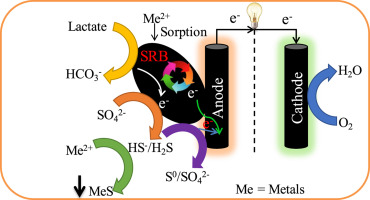当前位置:
X-MOL 学术
›
Chemosphere
›
论文详情
Our official English website, www.x-mol.net, welcomes your feedback! (Note: you will need to create a separate account there.)
Mixed sulfate-reducing bacteria-enriched microbial fuel cells for the treatment of wastewater containing copper
Chemosphere ( IF 8.8 ) Pub Date : 2017-09-13 , DOI: 10.1016/j.chemosphere.2017.09.048 Waheed Miran , Jiseon Jang , Mohsin Nawaz , Asif Shahzad , Sang Eun Jeong , Che Ok Jeon , Dae Sung Lee
Chemosphere ( IF 8.8 ) Pub Date : 2017-09-13 , DOI: 10.1016/j.chemosphere.2017.09.048 Waheed Miran , Jiseon Jang , Mohsin Nawaz , Asif Shahzad , Sang Eun Jeong , Che Ok Jeon , Dae Sung Lee

|
Microbial fuel cells (MFCs) have been widely investigated for organic-based waste/substrate conversion to electricity. However, toxic compounds such as heavy metals are ubiquitous in organic waste and wastewater. In this work, a sulfate reducing bacteria (SRB)-enriched anode is used to study the impact of Cu2+ on MFC performance. This study demonstrates that MFC performance is slightly enhanced at concentrations of up to 20 mg/L of Cu2+, owing to the stimulating effect of metals on biological reactions. Cu2+ removal involves the precipitation of metalloids out of the solution, as metal sulfide, after they react with the sulfide produced by SRB. Simultaneous power generation of 224.1 mW/m2 at lactate COD/SO42− mass ratio of 2.0 and Cu2+ of 20 mg/L, and high Cu2+ removal efficiency, at >98%, are demonstrated in the anodic chamber of a dual-chamber MFC. Consistent MFC performance at 20 mg/L of Cu2+ for ten successive cycles shows the excellent reproducibility of this system. In addition, total organic content and sulfate removal efficiencies greater than 85% and 70%, respectively, are achieved up to 20 mg/L of Cu2+ in 48 h batches. However, higher metal concentration and very low pH at <4.0 inhibit the SRB MFC system. Microbial community analysis reveals that Desulfovibrio is the most abundant SRB in anode biofilm at the genus level, at 38.1%. The experimental results demonstrate that biological treatment of low-concentration metal-containing wastewater with SRB in MFCs can be an attractive technique for the bioremediation of this type of medium with simultaneous energy generation.
中文翻译:

混合硫酸盐还原菌富集的微生物燃料电池,用于处理含铜废水
微生物燃料电池(MFCs)已被广泛研究用于将有机废物/底物转化为电能。但是,有机废物和废水中普遍存在有毒化合物,例如重金属。在这项工作中,使用富含硫酸盐还原细菌(SRB)的阳极来研究Cu 2+对MFC性能的影响。这项研究表明,由于金属对生物反应的刺激作用,在高达20 mg / L的Cu 2+浓度下,MFC的性能略有提高。Cu 2+的去除涉及在与SRB生成的硫化物反应后,作为金属硫化物的类金属从溶液中沉淀出来。乳酸COD / SO 4时同时发电224.1 mW / m 2在双室MFC的阳极室中,证明了2-的质量比为2.0,Cu 2+为20 mg / L,以及高的Cu 2+去除效率(> 98%)。MFC在20 mg / L的Cu 2+下连续10个连续循环的性能稳定,表明该系统具有出色的重现性。此外,在48小时内,Cu 2+的总有机含量和硫酸盐去除率分别达到85%和70%以上,达到20 mg / L。但是,较高的金属浓度和<4.0的非常低的pH值会抑制SRB MFC系统。微生物群落分析表明,脱硫弧菌在属水平上是阳极生物膜中最丰富的SRB,为38.1%。实验结果表明,在MFC中用SRB对低浓度含金属废水进行生物处理可能是一种有吸引力的技术,可以同时修复这种类型的介质并产生能量。
更新日期:2017-09-14
中文翻译:

混合硫酸盐还原菌富集的微生物燃料电池,用于处理含铜废水
微生物燃料电池(MFCs)已被广泛研究用于将有机废物/底物转化为电能。但是,有机废物和废水中普遍存在有毒化合物,例如重金属。在这项工作中,使用富含硫酸盐还原细菌(SRB)的阳极来研究Cu 2+对MFC性能的影响。这项研究表明,由于金属对生物反应的刺激作用,在高达20 mg / L的Cu 2+浓度下,MFC的性能略有提高。Cu 2+的去除涉及在与SRB生成的硫化物反应后,作为金属硫化物的类金属从溶液中沉淀出来。乳酸COD / SO 4时同时发电224.1 mW / m 2在双室MFC的阳极室中,证明了2-的质量比为2.0,Cu 2+为20 mg / L,以及高的Cu 2+去除效率(> 98%)。MFC在20 mg / L的Cu 2+下连续10个连续循环的性能稳定,表明该系统具有出色的重现性。此外,在48小时内,Cu 2+的总有机含量和硫酸盐去除率分别达到85%和70%以上,达到20 mg / L。但是,较高的金属浓度和<4.0的非常低的pH值会抑制SRB MFC系统。微生物群落分析表明,脱硫弧菌在属水平上是阳极生物膜中最丰富的SRB,为38.1%。实验结果表明,在MFC中用SRB对低浓度含金属废水进行生物处理可能是一种有吸引力的技术,可以同时修复这种类型的介质并产生能量。



























 京公网安备 11010802027423号
京公网安备 11010802027423号